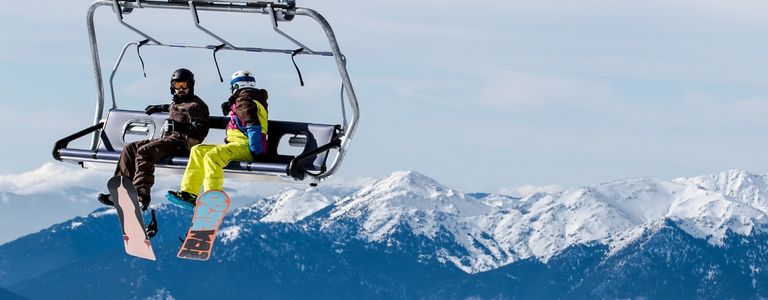It’s winter and it’s currently snowboarding season! But have you ever tried the sport? If you’ve ever wondered if snowboarding is like surfing and if it’s easy to learn, you’re not alone.
Snowboarding has become an increasingly popular winter sport, and many surfers have taken up the challenge of learning how to ride the slopes. In fact, there are many similarities between the two sports that can make snowboarding a great complementary sport for surfers.
In this article, we’ll explore the similarities between snowboarding vs. surfing, and provide tips and advice for surfers who want to try snowboarding.
We’ll also discuss the benefits of snowboarding for surfers and address some of the challenges that surfers may face when making the transition to snowboarding. So whether you’re a seasoned pro or a beginner, read on to find out how snowboarding can take your surfing skills to the next level.
Similarities between Surfing and Snowboarding
At first glance, surfing and snowboarding may seem like completely different sports. However, when you break them down and look at the technique, you’ll find that there are actually quite a few similarities between the two.
Here are some of the key similarities that make snowboarding a natural fit for surfers:
- Balance: Both surfing and snowboarding require excellent balance and body control, and a lot of these techniques are quite similar, with a focus on strong core muscles.
- Reading the terrain: In both sports, you need to be able to read the terrain and adjust your movements accordingly. In surfing, you need to anticipate the swell periods of the ocean and adjust your position in the lineup, to catch the waves at the right point and time. While In snowboarding, you need to be able to read the contours of the mountain and adjust your stance and edge angles to maintain control.
- Body position: The body positions used in surfing and snowboarding are surprisingly similar. Both sports require you to keep your weight centered over the board and to use your legs, feet, and core muscles to control your movements. In both cases, you want to keep your body low and your arms and upper body relaxed.
- Equipment: Both surfing and snowboarding require specialized equipment that is designed to help you ride waves or powder (snow). In both cases, the board is your main tool, and you need to be able to control it with precision to get the most out of your ride.
These are just a few of the similarities between surfing and snowboarding. By understanding these similarities, surfers can leverage their existing skills and experience to make the learning curve of snowboarding easier.
In the next section, we’ll explore how surfers can make the transition to snowboarding and start enjoying all that the slopes have to offer.
snowboarding basics for Surfers
If you’re a surfer interested in learning how to snowboard, you’re in luck. Because of the similarities between the two sports, many of the skills and techniques that you’ve already mastered as a surfer will translate directly to snowboarding.
Here are some tips and advice to help you get started:

- Take a lesson from a qualified instructor: This is the most important step for any new snowboarder, but it’s especially important for surfers. While the basics of balance, stance, and body positioning are similar, there are also important differences between the two sports that an instructor can help you navigate. An instructor can also give you personalized feedback and help you avoid developing bad habits that could hold you back later.
- Focus on your stance: As a surfer, you’re already comfortable with the idea of standing sideways and you know your preferred stance. However, the stance that you use for surfing (regular- or goofy stance) may not be the same one for snowboarding. Most snowboarders ride with their right foot forward, which is called the “goofy” stance. Don’t assume your snowboarding stance will be the same as in surfing. Experiment with two different stances to find the one that feels most comfortable and balanced for you.
- Rent or borrow equipment that fits: Having the right equipment is essential for any board sport, and snowboarding is no exception. It’s important to rent or borrow a snowboard, boots, and bindings that fit you properly. A well-fitting snowboard will help you maintain control and prevent unnecessary falls.
- Practice falling and getting up: Snowboarding can be a physically demanding sport, and falls are an inevitable part of the learning process – Just like surfing. Practice falling safely by tucking your head and rolling into a ball. Also, practice getting up quickly and efficiently to minimize downtime on the mountain.
- Start on a beginner slope: Once you’re comfortable with your stance and basic movements, it’s time to hit the slopes. However, it’s important to start on a beginner slope and work your way up gradually. A beginner slope will give you a chance to practice turns, stops, and controlling your speed without overwhelming you with steep inclines.
Just like surfing Snowboarding can be a challenging sport, so be patient and enjoy the process!
By following these specific steps and recommendations, you’ll be well on your way to mastering the basics of snowboarding and enjoying all that the slopes have to offer.
Surfing and snowboarding have loads of similarities... especially the learning curve! Expect a bumpy few weeks at the beginning. Fortunately, there are several transferable skills and once you've mastered one, the other is a little easier. Either way, falling is all part of the fun. Happy riding!
Benefits of Snowboarding for Surfers
Snowboarding is not only a fun and exciting sport in its own right, but snowboarding can also provide benefits that carry over to surfing.
Here are some of the ways that snowboarding can benefit surfers:
- Balance and coordination: Snowboarding requires balance and coordination, just like surfing. The movements and muscle groups used in snowboarding are similar to those used in surfing, so practicing one sport can help improve your performance in the other.
- Strength and endurance: Snowboarding is a physically demanding sport that requires strength and endurance. The movements involved in snowboarding work your core, leg muscles, and cardiovascular system, which can improve your overall fitness and stamina.
- Mental focus: Snowboarding requires mental focus and concentration, just like surfing. Staying present and focused while riding down the mountain can help sharpen your mental acuity and improve your ability to stay focused in the ocean when surfing.
- Fun and adventure: Ultimately, snowboarding is a fun and exciting sport that can provide a sense of adventure and fulfillment. Often it requires us to travel, so a snowboarding trip can give the same type of excitement as a surf trip, but you must love the cold. lol
- Ultimately trying out a new sport can be a great way to challenge yourself and discover new passions and interests.
Snowboarding can provide a range of benefits for surfers, that can improve their performance and broaden their skill set. So why not grab a snowboard and hit the slopes this winter? You might just discover a new way to have fun and stay fit.

Challenges of Snowboarding for Surfers
While there are certainly many benefits to snowboarding for surfers, there are also some unique challenges that come with learning a new sport.
Here are some of the main challenges that surfers may face when learning to snowboard:
- Different technique: Although there are some similarities between surfing and snowboarding, there are also many differences in terms of technique and your muscle memory can both be an advantage and disadvantage, when transitioning to snowboarding.
- Different equipment: Snowboarding also requires different equipment than surfing, which can take some getting used to. This includes the snowboard itself, as well as boots, bindings, and other gear. The biggest difference for surfers is getting used to having their feet locked into a fixed position on the snowboard.
- Different environment: Finally, snowboarding takes place in a very different environment than surfing, with snow and cold temperatures instead of waves and warm water. This can be a major adjustment for surfers who are used to the ocean and may take some time to get used to.
Despite these challenges, many surfers have successfully made the transition to snowboarding and found it to be a rewarding and enjoyable sport in its own right. With practice and dedication, it’s definitely possible to become a proficient snowboarder even if you’re starting from scratch. Just be prepared for a learning curve and be patient with yourself as you work to develop your skills on the slopes.
Conclusion
In conclusion, snowboarding can be a great complementary sport for surfers looking to stay active and improve their skills during the off-season. While there are certainly some challenges to learning a new sport, there are also many similarities between snowboarding and surfing that can make the transition easier.
By focusing on balance, coordination, and body position, surfers can leverage their existing skills to become proficient snowboarders in no time. And by practicing snowboarding, they can improve their fitness, endurance, and mental focus in ways that can carry over to their surfing performance.



